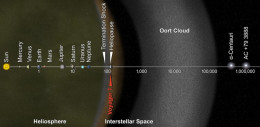Editor’s Note: In these last two weeks of 2015, we’ll be looking at a few selections from among the most-downloaded papers published in AAS journals this year. The usual posting schedule will resume after the AAS winter meeting.
The Closest Known Flyby of a Star to the Solar System
Published February 2015
Main takeaway:
A team of scientists led by Eric Mamajek (University of Rochester) have determined that, 70,000 years ago, space got a little crowded: a low-mass binary star system passed by our solar system at the narrow distance of 0.82 light-years. This is near enough for the system — known as Scholz’s star — to have actually clipped the outer edge of the Oort cloud.

Scholz’s star passed our solar system at a distance of about 0.82 light-years (52,000 AU). This is about 1/5 of the distance to the nearest star system, Alpha Centauri, and it’s within the outer edge of the Oort cloud. [NASA]
Why it’s interesting:
This is the closest known encounter of a star to our solar system. The discovery of this system’s trajectory suggests that there may be other lurking, faint stars that have had (or will have!) close encounters with us.
About the discovery:
Scholz’s star’s flyby was discovered as a result of its unusual transverse velocity: it’s only 20 light-years away, yet it’s moving across the sky at a sluggish 3 km/s. This was a clue that it probably has a large radial velocity — and sure enough, follow-up measurements determined the radial velocity of Scholz’s star to be 83 km/s, moving away from us. Modeling of the system’s trajectory allowed Mamajek and collaborators to reconstruct the path it took past our solar system.
Citation
Eric E. Mamajek et al 2015 ApJ 800 L17. doi:10.1088/2041-8205/800/1/L17

